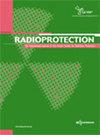通过与已知生物后果的比较来评估货物扫描中的辐射风险
IF 1.8
4区 医学
Q4 ENVIRONMENTAL SCIENCES
引用次数: 1
摘要
本研究提出一种快速、简单、低成本的方法,可用于评估用于货物和集装箱检验设施的辐照线的辐射安全性。使用的辐射发射设备是史密斯海曼粒子加速器型号HCVP4029,工作在4.5 MeV。使用个人辐射监测仪Ultra Radac mod MRAD 111(盖革-穆勒)进行辐射剂量测量。估算了两个设施的环境等效剂量H*(10): A(真实)(每次扫描1.12E-03毫西弗)和B(虚构)(每次扫描3.25E-03毫西弗)。引入了无量纲因子R,它表示设施a和B的两个特定扫描量之间的比率,作为评估放射安全水平的参考。本研究使用基于R因子的简单替代安全评估来比较设施A和设施B。无量纲的r值似乎能够促进人员和公众对风险水平的感知,即使没有固定的尺度。本文章由计算机程序翻译,如有差异,请以英文原文为准。
Evaluation of the radiological risk in cargo scanning by comparison with known biological consequences
This study proposes a quick, easy, and low-cost method that can be used to assess the radiological safety of an irradiation line used for cargo and container inspection facilities. The radiation-emitting equipment used was a Smiths Heimam particle accelerator model HCVP4029 operating at 4.5 MeV. The radiation dose measurements were performed using a personal radiation monitor Ultra Radac mod MRAD 111 (Geiger–Muller). The ambient equivalent dose H*(10) was estimated for two facilities: A (real) (1.12E-03 mSv per scan) and B (fictitious) (3.25E-03 mSv per scan). The dimensionless factor R, which represents a ratio between two specific scanning (Ss) quantities regarding the facilities A and B, is introduced as a reference for assessing the level of radiological safety. This study compares facilities A and B by using a simple alternative safety assessment based on the R factor. The dimensionless R-value appears to be able to facilitate both the personnel’s and the general public’s perception of risk levels, even with no fixed scale.
求助全文
通过发布文献求助,成功后即可免费获取论文全文。
去求助
来源期刊

Radioprotection
ENVIRONMENTAL SCIENCES-PUBLIC, ENVIRONMENTAL & OCCUPATIONAL HEALTH
CiteScore
3.30
自引率
54.50%
发文量
35
审稿时长
>12 weeks
期刊介绍:
Radioprotection publishes articles on all aspects of radiological protection, including non-ionising as well as ionising radiations. Fields of interest range from research, development and theory to operational matters, education and training. The very wide spectrum of its topics includes (theoretical and practical aspects): dosimetry, instrument development, specialized measuring techniques, epidemiology, biological effects (in vivo and in vitro) and risk and environmental impact assessments.
 求助内容:
求助内容: 应助结果提醒方式:
应助结果提醒方式:


